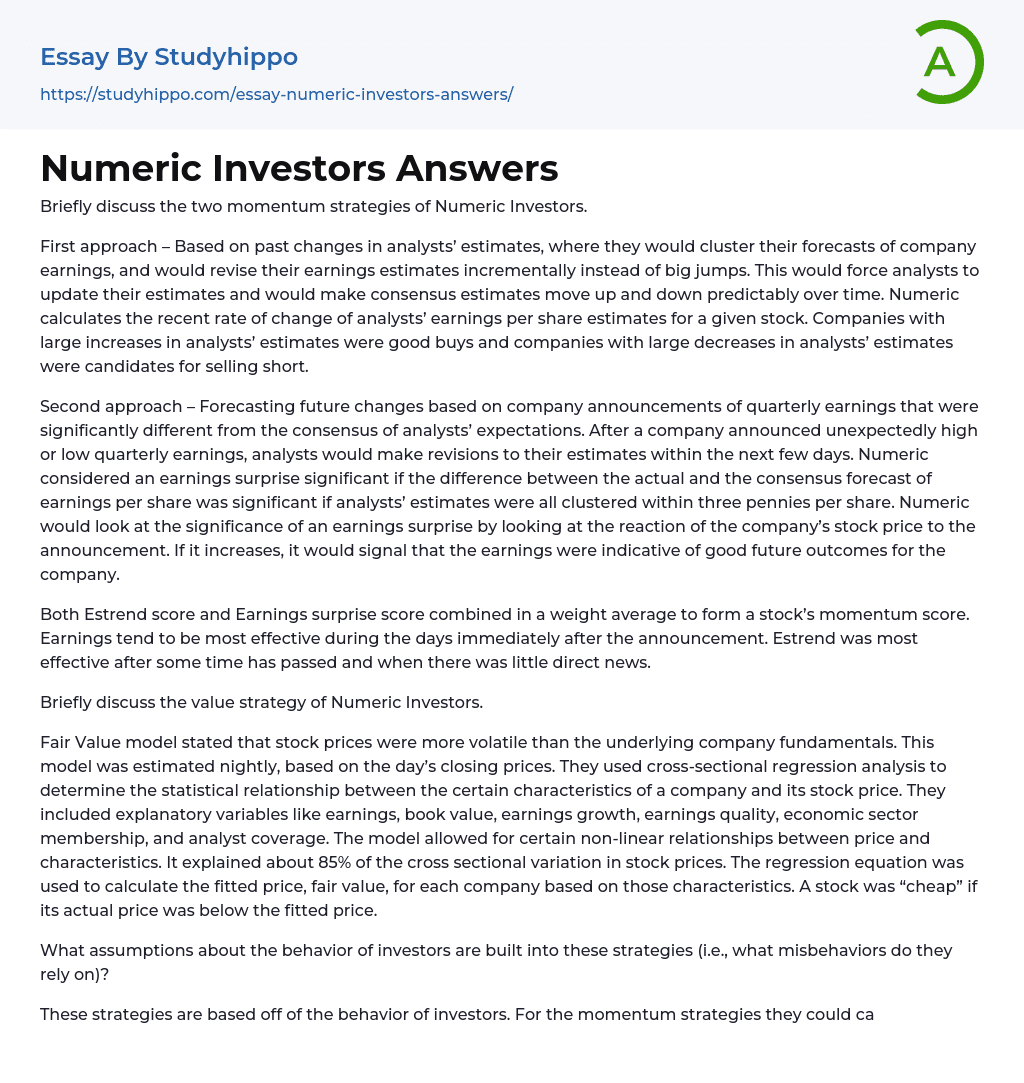Briefly discuss the two momentum strategies of Numeric Investors.
First approach – Numeric Investors applies a strategy based on past changes in analysts’ estimates. They cluster the forecasts of company earnings and revise their earnings estimates incrementally, rather than making significant jumps. This approach prompts analysts to update their estimates and causes consensus estimates to move predictably over time. Numeric calculates the recent rate of change of analysts’ earnings per share estimates for a given stock. Companies experiencing substantial increases in analysts’ estimates are considered good buys, while those facing significant decreases in estimates are identified as potential candidates for short-selling.
Second approach – Numeric Investors employs a strategy that involves forecasting future changes by analyzing company announcements of quarterly earnings that deviate significantly from analysts’ expectations. This approach allows
...them to identify opportunities based on the disparity between actual earnings and the consensus forecasted by analysts.
Following a company's unexpected announcement of high or low quarterly earnings, analysts typically revise their estimates within a few days. Numeric determines an earnings surprise to be significant if the difference between the actual earnings per share and the consensus forecast exceeds three pennies per share, while all analysts' estimates are closely grouped. Numeric assesses the significance of an earnings surprise by examining the reaction of the company's stock price to the announcement. If the stock price increases, it suggests that the earnings results are indicative of positive future outcomes for the company. The Estrend score and Earnings surprise score are combined in a weighted average to calculate a stock's momentum score. Earnings tend to have the greatest impact in the days immediately following the announcement.
Estrend was most effective after a
period of time has elapsed and when there was minimal direct news.
Discuss briefly the value strategy employed by Numeric Investors.
The Fair Value model affirmed that stock prices exhibited greater volatility compared to the fundamental aspects of the underlying company. This model was computed daily, utilizing the closing prices recorded for the day. Cross-sectional regression analysis was employed to ascertain the statistical correlation between specific characteristics of a company and its corresponding stock price.
Within the regression analysis, various explanatory variables were incorporated such as earnings, book value, earnings growth, earnings quality, economic sector membership, and analyst coverage. The model took into account certain non-linear relationships between price and these characteristics. This comprehensive approach accounted for approximately 85% of the variation in stock prices across different companies. By utilizing the regression equation, the fair value for each company was determined by calculating the fitted price based on these specific characteristics.
A stock was considered "cheap" if its actual price was lower than the fitted price. What assumptions about investor behavior underlie these strategies (i.e., what types of misbehavior do they depend on)? These strategies are founded on investor behavior. In the case of momentum strategies, investors may perform extensive calculations, but ultimately they prefer to follow the crowd. For instance, in the earnings surprise strategy, investors would only buy into a company if the stock price rises after an announcement.
That would be the ultimate rule they have before going in. Regarding the value strategy, when a closing price stands out from the rest of the days, it might affect the determination of cross-sectional regression analysis. Regarding the initial momentum approach, they invest in their strategy based on
numbers, and they must have confidence in their approach because sometimes success or failure depends on it.
- Chief Executive Officer essays
- Convenience Store essays
- Firm essays
- Training And Development essays
- Unilever essays
- Variable Cost essays
- Virgin Group essays
- Bargaining essays
- Entity essays
- Pest analysis essays
- Asset essays
- Depreciation essays
- Discounted Cash Flow essays
- Foreign Direct Investment essays
- Funds essays
- Internal Rate Of Return essays
- Revenue essays
- Day Trading essays
- Futures Trading essays
- Capital market essays
- Million essays
- Payment essays
- Rate Of Return essays
- Funding essays
- Hedge Fund essays
- Leadership and Management essays
- Change Management essays
- Project Management essays
- Knowledge Management essays
- Operations Management essays
- Quality Management essays
- Risk Management essays
- Scientific Management essays
- supply chain management essays
- Performance Management essays
- Time Management essays
- Brand Management essays
- Total Quality Management essays
- Risk essays
- Manager essays
- Leadership essays
- Business Ethics essays
- Board Of Directors essays
- Product Management essays
- Comparative Analysis essays
- Decision Making essays
- Dispute Resolution essays
- Stress Management essays
- Business Management essays
- Brand Equity essays




